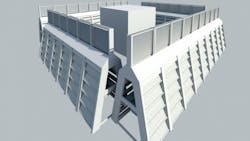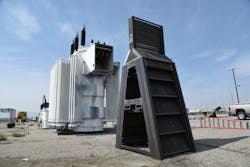Idaho National Laboratory Scientists Design Ballistic Barrier System
Until 2013, an electricity substation in California was surrounded by nothing more than a chain link fence, just like thousands of others across the United States. That fence proved ineffective when gunmen fired up to 150 rounds at the substation, causing more than $15 million in damage to 17 transformers. Although the substation owner prevented loss of service to customers by diverting power, it was clear that a similar attack at a large substation had the potential to knock out power to millions of people.
In response to this attack and others, the Federal Energy Regulatory Commission enacted new standards for physical security of critical substations.
As a result, Idaho National Laboratory (INL) developed and demonstrated a patent-pending ballistic barrier system to protect substations from attack.
INL’s ballistic barrier system is designed to protect substations from potential threats as varied as bullets, vehicles laden with explosives and tornado-strength winds. This effort is part of the lab’s growing mission to make the nation’s critical infrastructure -- including the grid -- more reliable, safe and resilient.
“We are trying to be proactive and provide solutions to threats when they emerge,” said Chad Landon, head of INL’s Defense Systems Materials Technology and Physical Analysis department. “Based on the 2013 incident and similar situations, we decided to come up with a solution.”
It’s called the Transformer Protection Barrier, designed by INL Armor Technical lead Henry Chu. The prototype is robust enough to protect transformers from high-powered rounds of ammunition, yet relatively inexpensive and easy to set up and move around, unlike permanent systems requiring concrete footings. Each barrier unit consists of four components: an A-shaped frame, two armor cassettes that slide into the frame, and the “top hat” -- an optional armor extension.
The armored pieces are constructed from low-cost metal materials so they can be fabricated locally. Each unit costs less than $36,000 to build, weighs about 6,000 pounds, and is designed to be assembled on-site with simple tools, forklifts or lifting cranes.
A single unit can be moved with a forklift, remain stable in winds exceeding 100 miles per hour and withstand attack from the same type of weapon and ammunition used in the California substation attack. This prototype is not only strong, but also flexible. Multiple units can be linked together to form a complete ballistic barrier against a variety of threats.
To test out the construction process, the team recruited linemen who operate the lab’s own 61 mile electricity transmission and distribution system. And to confirm that construction was really as simple as the researchers had planned, they used only equipment common to all utilities.
“We gave them a set of drawings with no directions,” Chu said. “From the drawings, they developed the steps for construction.”
According to Project Manager Scott McBride, the crew not only suggested modifications but also provided rigging tips that will improve the assembly process in the field. Based on their recommendations, the rigging design was changed.
“Using the line crew was important,” McBride said. “The units were not designed by the linemen, so getting their input on installation was very valuable.”
Chu said the linemen had his apparatus assembled in less than an hour. The successful demonstration showed assembly can be done by power companies, using their own tools. Utilities could buy this armor and erect it with equipment they have on hand, with untrained personnel.
And once it goes up, it’s going to stay up, Landon said. “After the linemen set it up, we took it out to the National Security Test Range and shot at it,” Landon said. “The unit will withstand 50-caliber rounds -- the standard will probably not require this level of protection.”

